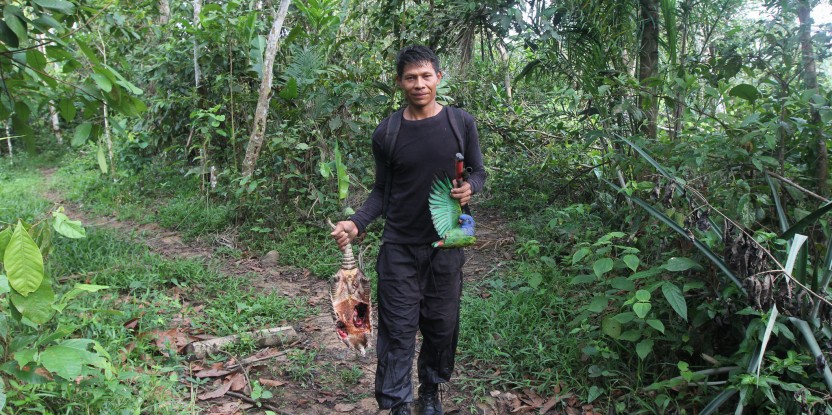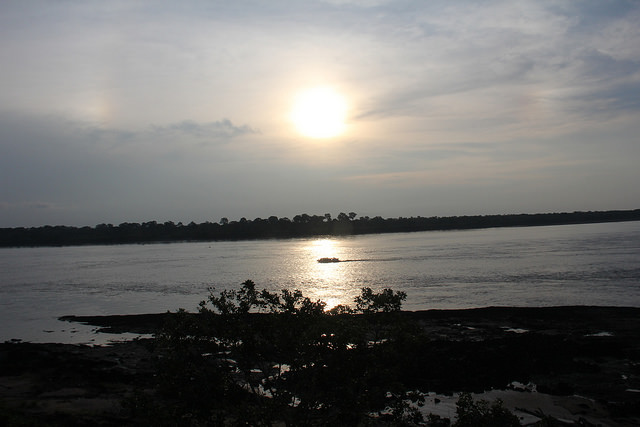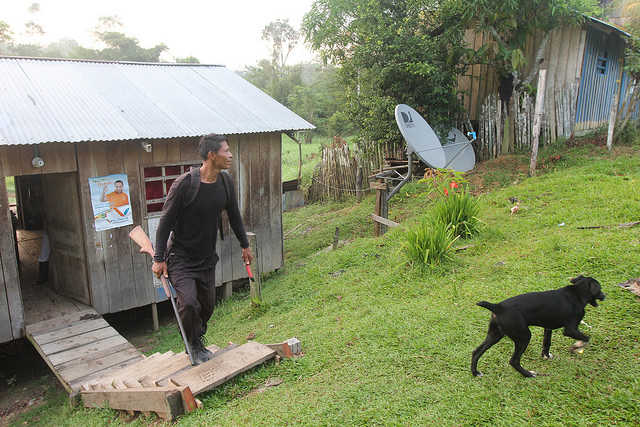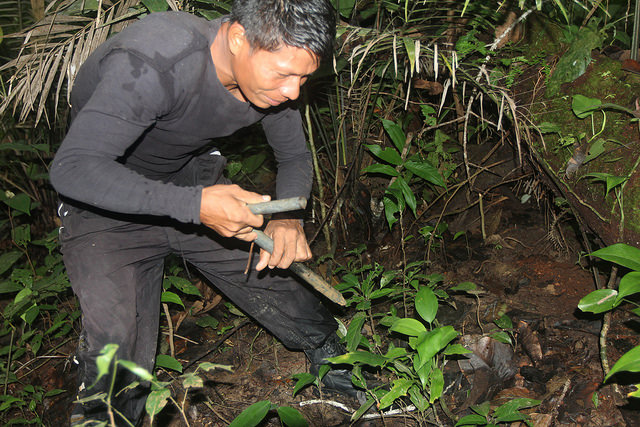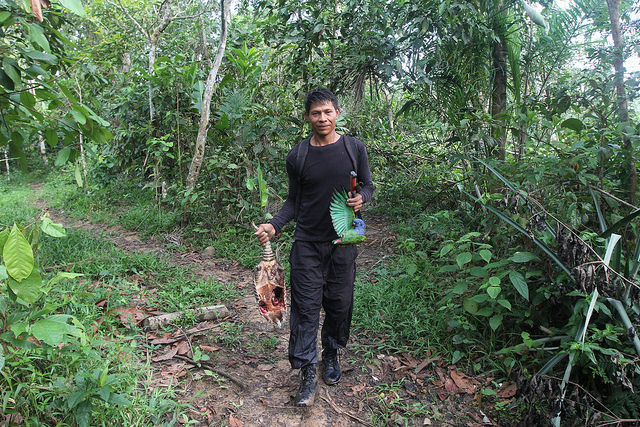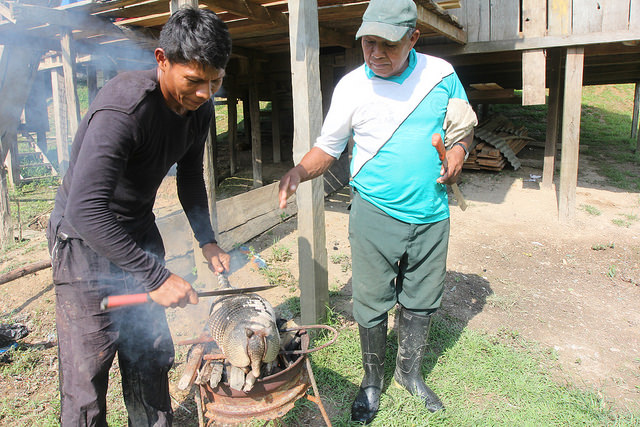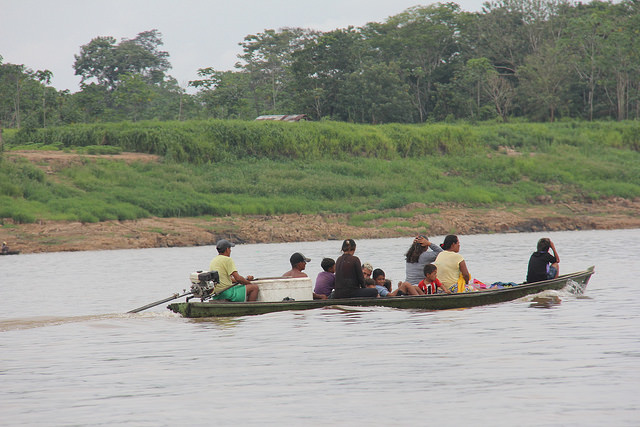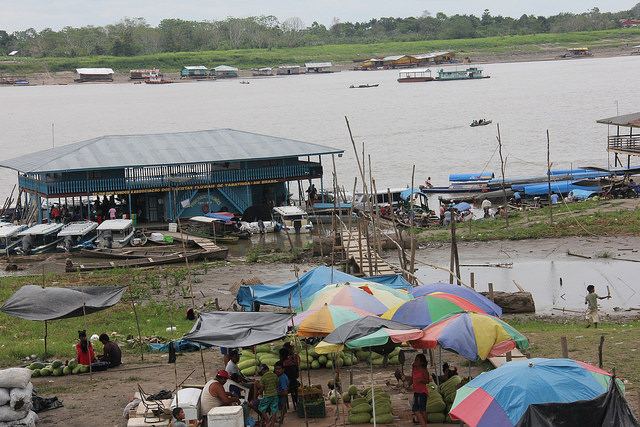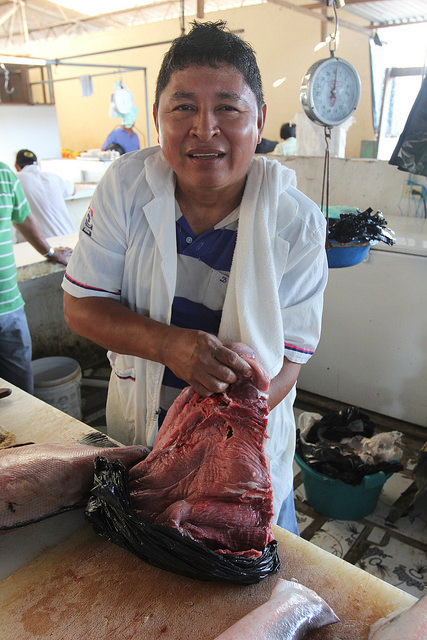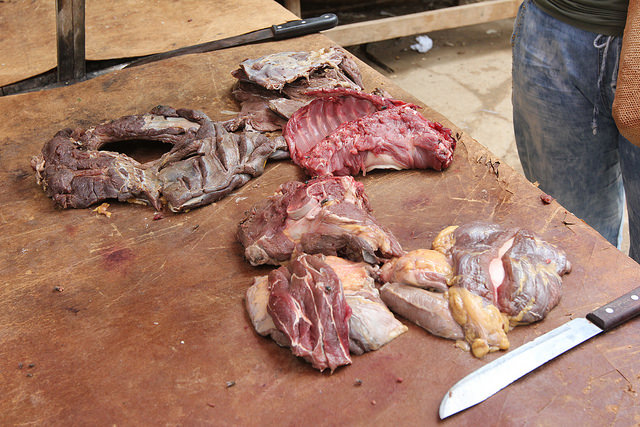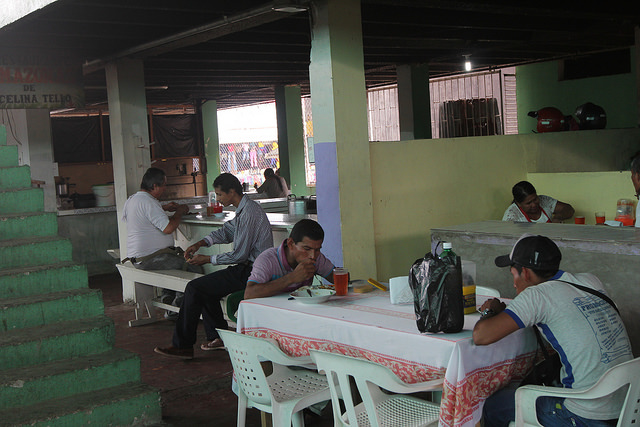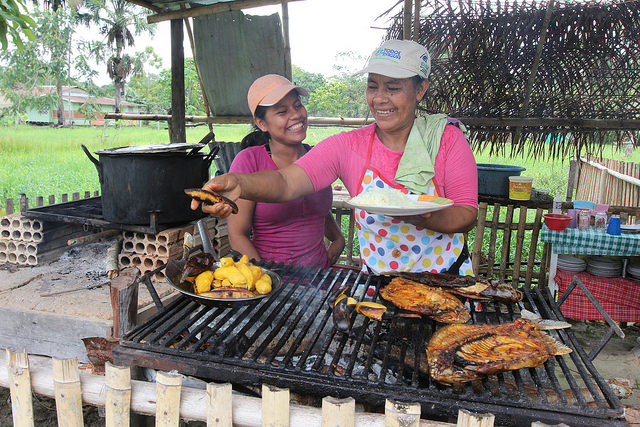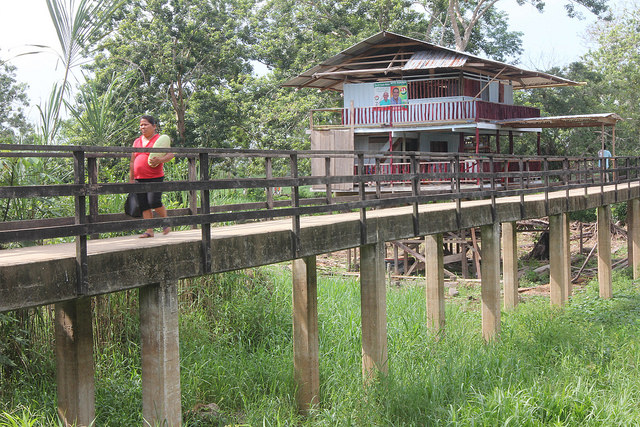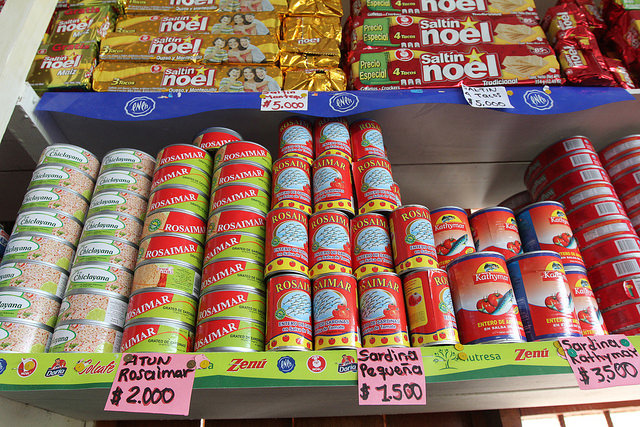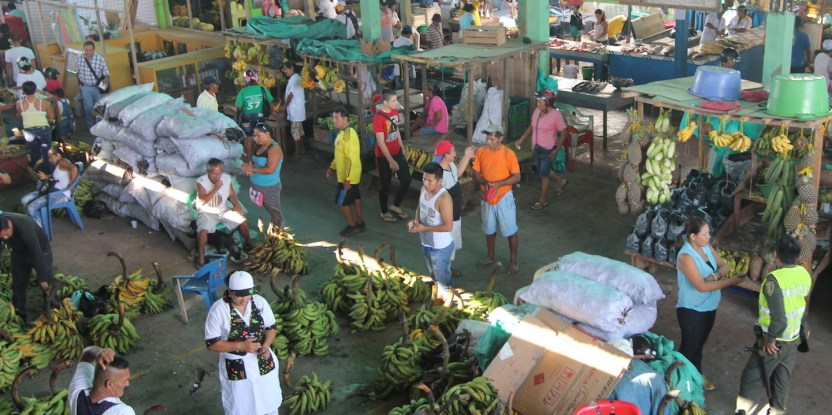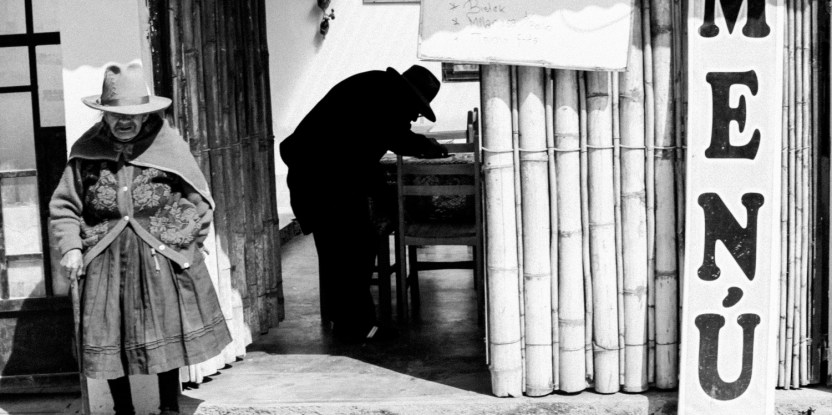Striding through the forest, beneath trees still dripping pre-dawn dew, Diomedes Silva suddenly veered off the path and into the underbrush. Ducking under a low branch, he nodded with satisfaction—the trap he had set under a fallen log the day before had nabbed an armadillo.
The trick is to know the path the animal will follow, he said, pointing to a faint, narrow trail through the fallen leaves, which was barely visible to the untrained eye.
Three other traps came up empty, but Silva returned home an hour later with the armadillo and a parrot he had felled from a treetop with a deftly aimed shot.
As he built a fire to clean the armadillo behind his simple, wooden house at the edge of Puerto Nariño, a town of about 7,000 people beside the Amazon River in the southernmost corner of Colombia, a neighbor stopped to greet him and ask the price of the meat.
By mid-afternoon, Silva and his wife, Marcela Rojas, had given some of the armadillo meat to relatives and set some aside for their own family. There was a little left over, which they considered selling to someone in the community.
That is typical of the way Ticuna people, such as Silva and his wife, use the meat from the animals they hunt.
“Bushmeat is an important source of food for indigenous people in rural communities,” said Nathalie Van Vliet, a geographer and associate researcher at the Center for International Forestry Research (CIFOR), who studies the hunting and commercialization of bushmeat in the Amazon basin where the borders of Colombia, Brazil and Peru converge.
Wild meat also serves other purposes, she said: it holds a special place on the menu for celebrations and cements social bonds as people share meat with relatives and friends.
But if Silva and his neighbors sell the meat from game they hunt, they break the law.
UNDER THE TABLE
Under Colombian law, “subsistence” hunting is for the family table. Hunters who sell bushmeat must have a commercial permit, which requires environmental impact studies that are beyond the means of most people in rural communities.
But that doesn’t stop the trade—it just pushes it underground.
Hunters or their relatives sell meat to neighbors or offer it in the plaza in Puerto Nariño, keeping it discreetly out of sight until the buyers who know them seek them out.
Sometimes, the police turn a blind eye; other times, they crack down. The meat of animals such as armadillo, tapir, deer or the large rodent called paca is popular and often sells out before the police arrive, according to local hunters.
To keep things simple, the price—a couple of dollars a kilo, more than the frozen chicken imported from Brazil, but less than beef—is usually the same for all types of bushmeat.
Some hunters also send packages by passenger boat to relatives in Leticia, a city of about 30,000 people two hours downriver.
Like most Amazonian towns, Leticia keeps one foot in the forest. Many residents have moved there from rural villages, in search of jobs or better education for their children. When they get hungry for a taste of home, they ask relatives to send bushmeat or they seek it out in the local market.
Even residents who were born in the city like the taste, the variety or the cachet that comes with eating a novel meat, even though the clandestine trade may make it more expensive than others, Van Vliet said.
UNDER COVER OF DARKNESS
In Leticia and neighboring Tabatinga, Brazil, buying bushmeat isn’t simply a matter of strolling among the stalls selling fish, vegetables or beef and asking who sells wild game.
Only a handful of vendors handle the meat, and they are cautious. It took Van Vliet and her team from Colombia’s Fundación SI, hours of hanging around the market, eating at informal stalls and shopping with local residents, to gain the vendors’ trust.
Once they did, they found themselves inside a trade that had never been studied because it stays largely out of sight, Van Vliet said.
The shipments of meat arrive on small boats that tie up at the small port along the river, often at night, when there are fewer prying eyes.
Hunters might sell directly to a market vendor or to an intermediary, often a merchant who buys bushmeat in villages where he also peddles pots and pans, dry goods, ammunition or other wares.
Vendors store the meat in plain wrappers in freezers in their market stalls, where they are likely to display fish—the prized giant pirarucú or paiche (Arapaiama gigas), fresh or salted, or the popular gamitana (Colossoma macropomum).
Because regulations prohibit catching those species during certain months, selling bushmeat helps the vendors even out their income over the year.
Mobile phones revolutionized the vendors’ business by enabling them to take orders or alert customers when a shipment arrives. That helps them keep the business out of sight, but does not completely eliminate the risk of being caught.
Police sometimes raid the markets looking for bushmeat or for fish caught out of season. They confiscate the meat—probably taking it home to eat, the vendors comment wryly—or ask for bribes.
The same authorities who sometimes crack down on the bushmeat trade are also customers from time to time, said one vendor named Misael, as he took time out from filleting a gamitana in his Leticia market stall to weigh a cut of venison.
His business ebbs and flows with the seasonal rise and fall of the water level in the Amazonian rivers. Meat is scarce by August or September, when the river is low and transportation is more difficult.
He gets a steadier supply during high-water season in the first half of the year, when hunters can canoe through the flooded forest to higher ground where wild animals take refuge.
OUT OF THE SHADOWS
Both hunters and vendors would like the small-scale sale of bushmeat legalized on the border of Colombia, Brazil and Peru.
They argue that a legal market would eliminate the cost of losing their meat in a police raid or paying bribes to avoid confiscation. It would also take away the stigma of involvement in an underground market, where other vendors point at them and whisper that what they do is illegal.
Legalizing the trade would probably increase competition, but a vendor in the Tabatinga market, known to Van Vliet by the nickname “Chicle,” said he wouldn’t mind.
“If there were more competition, the price would come down, but we’d make up the difference in volume,” he said.
“The vendors would like the trade to be legalized,” said Jessica Moreno, a researcher from Fundación SI, which works in collaboration with CIFOR. “It would bring them out of the shadows.”
The hazard is that legalizing commercial hunting in places like Puerto Nariño, even on a small scale, could encourage more people to hunt, or increase the amount of game being taken.
“If it’s legalized, people will hunt and sell more. Restaurants will buy more, too,” Silva said. “It would have to be controlled.”
Both hunters and vendors worry that game species could become depleted and said regulations would be needed to ensure that the number of animals holds steady.
LOCAL RECOMMENDATIONS
Hunters from the Ticuna, Cocama and Yagua Reserve or resguardo, the indigenous territory that includes Puerto Nariño, where Silva lives, attended a workshop in Leticia in October 2015 where they talked with researchers, government officials and conservationists about ways to regulate the small-scale bushmeat trade without depleting populations of game animals.
The recommendations emphasized local participation in designing regulations and monitoring the impact of hunting, said Van Vliet.
The meat is pure. It doesn’t have chemicals in it - children eat it and they grow up strong and healthy
Hunters and some village leaders in the Ticoya Resguardo say that the definition of “subsistence” is too narrow, as villagers also need cash to buy items such as soap, kitchen utensils, clothing, school supplies, gasoline for their boats—the only form of local transportation—and ammunition for the shotguns they use for hunting.
And with permits for commercial hunting beyond the reach of indigenous communities, the workshop participants urged the government to take steps to differentiate between small-scale commercial hunting by community hunters and large-scale commercial hunting.
Participants also called for a national list of game species that takes into account the local context and sets out quotas for each species, based on criteria such as the species’ ecological characteristics and local population dynamics, protected status and economic value.
Environmental impact statements should consider not only factors such as effects of hunting on game species, but also a plan for distributing the economic benefits of hunting and for evaluating the impact on food security and nutrition in communities, the participants said.
Legalizing the small-scale bushmeat trade would give hunters in the reserve a larger market close to home, Silva said.
He would like to be able to sell wild game—which local children like and which their parents prize for its nutritional value—to the government-run school nutrition program in Puerto Nariño.
Sara Armas Díaz, a Cocama grandmother who hunts with her dog, a pitbull named Lucas, agreed.
“The meat is pure,” she said. “It doesn’t have chemicals in it. Children eat it and they grow up strong and healthy.”
We want you to share Forests News content, which is licensed under Creative Commons Attribution-NonCommercial-ShareAlike 4.0 International (CC BY-NC-SA 4.0). This means you are free to redistribute our material for non-commercial purposes. All we ask is that you give Forests News appropriate credit and link to the original Forests News content, indicate if changes were made, and distribute your contributions under the same Creative Commons license. You must notify Forests News if you repost, reprint or reuse our materials by contacting forestsnews@cifor-icraf.org.
